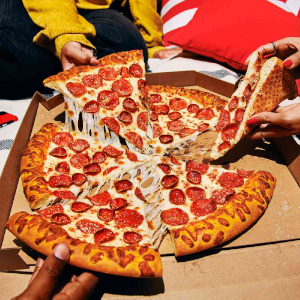I don’t know what it is about Pizza… My post idea for today started as a recent upsurge in Pizza ‘innovation’ and crossovers, etc. But it quickly turned into a much larger and wider investigation probing the psychology of the ‘Universal Pie’…
 Pizza: The ultimate fulfillment of a fundamental, ancient,
Pizza: The ultimate fulfillment of a fundamental, ancient,
deep-seated cultural/collective memory!
We often forget that Pizza, as most of us know it, came from Italy with waves of 19th and 20th century migration from sunny Italy to all parts of North and South America. As such, we’ve been denying ourselves the joys of hundreds of other savoury-topped-flatbread traditions from all over Europe, the middle East and Asia.
This isn’t the first time I’ve posted about Pizza’s mysterious universal appeal. But it will be the first that attempts to analyse the phenomenon. And that’s going to have to include a parallel probe of the influence of flatbreads on global diets and cultures.
It all started with flatbread
In short, it appears that savoury-topped flatbread fulfills a deep-seated, universal yearning for a balanced meal that can effortlessly be adapted to the national dining traditions of just about any cuisine. Flatbread has been around much longer than what most modern European-based cultures call ‘bread’. In fact, they have been around since before yeast came into use, a few thousand years ago.
Flatbreads go back to before humans started to seriously consider settling down in a single place, building permanent houses and inventing what we would call farming. They have a longer storage life than modern bread, and pack more densely and efficiently for long hunting or trading trips.
We still yearn for flatbreads
By the way: Have you ever noticed that yeast-raised European breads are almost always baked in leavened loaves, then sliced for serving? I’ve always thought we slice bread so it will more closely resemble the flatbread of our collective memories, and can be used in similar ways.
Flatbreads have long been used in a whole catalogue of ways: folded, pocketed, cupped in the hand, layered in conventional sandwiches with fillings between two pieces, and so on. It can also be cut or be torn into smaller pieces and employed like a spoon, or a dipper for foods such as Tahini, Tabouleh and Hummus.
A single slice also makes a natural, edible serving plate. Of course, one of flatbread’s major advantages is, when you get to eat with your fingers, they stay clean. That was a huge breakthrough in its time! Modern eating utensils have only been wide use for a few hundred years, since the Renaissance, when Catherina di Medici married Henry II of France and brought them from Italy to the French court – in the heart of Western European culture.
Segue to the universal popular table
In one post of mine, I ran down a whole bunch of dishes that use flatbread in a number of different ways. They come from different cultures and feature widely differing toppings and stuffings. I offered that post to illustrate the spectacularly blurred line between pizza and foods that employ bread-plus-other-stuff. In that one, we tackled the ever-contentious question of what’s a pizza and what’s not. Don’t miss the link-out from that post to a delightful culinary travelogue titled Pizza Around The World.
Consider this…
You can use flatbread in any number of ways. But the ubiquitous Pizza may just represent the optimum ratio of bread to toppings/stuffings. It may also represent the ultimate mode of visual artistic presentation; open-faced creations with crispy golden crusts framing colourful food pictures from Mondrian-inspired geometrics to Jackson Pollack splashes. And whereas you’d never dream of laying even a finger tip on a Mondrian or a Pollack, you can literally immerse yourself in the tactile experience of a pizza. Not only are you encouraged to touch the Pizza, you’re expected to eat it. With your hands! The ultimate fulfillment of a fundamental, deep-down cultural/collective memory!
Viva la Pizza!
~ Maggie J.

